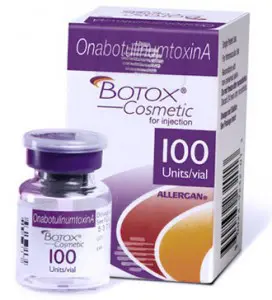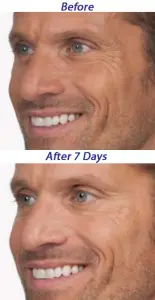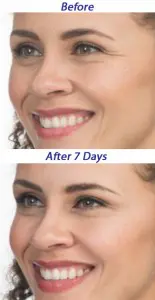UNDERSTANDING BOTOX® COSMETIC FACIAL TREATMENTS
I can drive a car. I can change a flat and add oil or windshield wiper fluid when the light tells me to, but I’m not a mechanic and don’t understand motors and transmissions. Patients often have a similar experience when it comes to their BOTOX® Cosmetic treatments. They like the results but don’t have a good understanding of how it works and how it can be used. My intention here is to present information that will make practical sense to patients so that they can maximize their experience with a BOTOX® Cosmetic treatment.
The bacteria Clostridium botulinum produces a toxin that causes the illness called botulism. It is characterized by muscle weakness which can effect breathing, swallowing, speaking and seeing. Large muscle movement of the arms and legs can also become involved. Botulinum toxin Type A is highly purified and used in small amounts for cosmetic purposes. The chemical name for BOTOX® Cosmetic is Onabotulinumtoxin A.

There are several very important things to know about BOTOX® Cosmetic before an initial treatment. First of all, BOTOX® and BOTOX® Cosmetic are both Onabotulinumtoxin A, but they are used differently. BOTOX® is used for medical purposes such as migraine, large muscle spasm, cervical dystonia and bladder dysfunction. BOTOX® Cosmetic is used for cosmetic treatments. The difference is not in the product but in the number of units used for treatments. Hundreds of units of BOTOX® can be used for medical issues, while a much smaller number of units are used for cosmetic treatments. There have been reports of botulism and deaths occurring after medical BOTOX® treatments. However, these serious adverse effects have not been reported with BOTOX® Cosmetic treatments.
Another thing to understand about all neurotoxins including BOTOX® Cosmetic is that there is an albumin component in the products. People who are allergic to egg white may have an allergic reaction to that component. In addition, it is important to understand that the albumin component is derived from human plasma donors. The albumin from these donors has been highly purified, and there has been no report of transmission of any viral illness.
Of course there are minor transient adverse effects that can happen with any treatment which can include bruises, redness, swelling and soreness. Some other adverse events reported after BOTOX® Cosmetic treatments include transient headache, flu-like symptoms and numbness in the area of injection.
So you understand how it works, read about the risks and are ready to try BOTOX® Cosmetic. Let me go over several things to think about before a treatment.
If you are prone to bruising, you may want to pre-treat with arnica for several days beforehand. Arnica is a homeopathic medication that can be purchased in a drug store or health food store and helps decrease the incidence of bruising. Also you may not want to take medications that promote bleeding for several days before a treatment such as aspirin, ibuprofen or naproxyn. Make sure your injector knows if you are taking a prescribed blood thinner, but do not stop the medication. If a bruise does develop from a treatment, bromelain may help it resolve faster. Bromelain is an enzyme found in pineapple, comes in pill form and can be found in health food stores.
Another thing to think about is the timing of a treatment. It can take up to two weeks for a treatment to take full effect. If you have an event coming up that you want to look refreshed for, give yourself enough time for any bruising that might occur to resolve, for the full effect to happen and for any touch up that might need to be done.
I would like to go over how BOTOX® Cosmetic is used and placed to create the look you are trying to achieve. The main areas of the face that BOTOX® Cosmetic is used are the glabella (the area between your eyebrows that are associated with frowning or looking angry), the forehead (the area above your eyebrows that have lines running horizontally across) and the crow’s feet (the area lateral to your eyes that form when you smile). 
The muscles of the glabella are called depressor muscles. In other words, when they contract they bring your eyebrows together and down forming the frown or angry look and the associated vertical lines (the 1s,11s,111s) that can appear between your eyebrows. The muscles that raise your eyebrows are called elevator muscles. 
Of concern for a lot of female patients is the effect of the brow dropping. If you have a heavy brow, heavy upper eyelids or eyebrows that sit below the orbital rim, you will notice any weakening of the forehead elevator muscles. A typical comment from someone who experiences that effect will be that they have to lift their eyebrow to apply their upper eye shadow.
The muscle around the eye is circular. Weakening the lateral side of this muscle (the side of the eye near the ear) will soften the lines formed when smiling. There is no effect on the eyelids. Softening these lines is another way to highlight the eye area. This area is very vascular and an injection bruise is not uncommon in this area.
Allergan wants patients to understand how many units are being used in a treatment area. Was the amount injected adequate to make a change in the treatment area? Were more units needed to produce the desired effect? Was a different treatment pattern needed? An injector should have this information in a record that can be reviewed prior to a subsequent treatment.
The number of units that are typically injected in a given area differ. Allergan recommends 20 units of BOTOX® Cosmetic in the glabellar area. They also recommend 24 units total for treating crow’s feet. Some patients may need more or less units for these areas. There is no FDA approval for using BOTOX® Cosmetic in the forehead only because no formal study has been done. However, it is a commonly treated area, and the number of units used varies per patient.
After a treatment, patients are advised to remain upright for 4 hours while BOTOX® Cosmetic is being absorbed into the muscle. Facial expressions such as smiling, raising your eyebrows and frowning may help the product find the active muscle if done within the first 30 minutes. Patients are advised not to do any exercise or have any strong sun or tanning bed exposure for 24 hours. Also the injection area should not be compressed or massaged.
As the BOTOX® Cosmetic treatment starts to take effect, there are several things to look for. Any asymmetry in a facial expression that starts to show up should be addressed and touched up. 
After two weeks if you are still having a significant amount of movement in a treated area, it should be looked at. It may be that the area was undertreated or that the injections were not placed correctly. Also patients can develop an antibody to a protein component of BOTOX® Cosmetic which may result in a blunted response to a treatment.
I hope I’ve given you some practical information and better understanding about BOTOX® Cosmetic and a treatment experience with it. Please contact me at Willo MediSpa if you would like more information or further explanation. I can be reached by email at [email protected], by phone at 602-296-4477 or by stopping by the office at 201 E. Monterey Way, Phoenix, AZ 85012.

Dr. Nello Rossi – Willo MediSpa
Phoenix, AZ 85012
Phone: (602) 296-4477
Email: [email protected]
Website: https://willomedispa.com
Office Hours
Sunday – Monday: Closed



 SkinMedica® Store
SkinMedica® Store